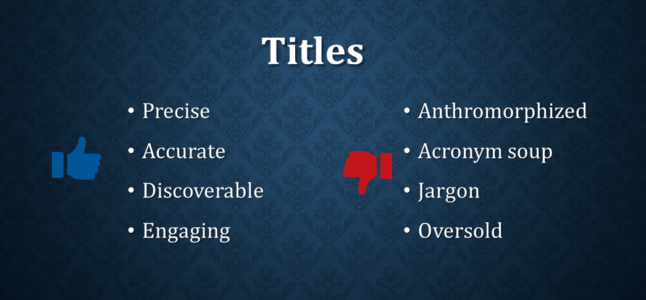For 17 years as an editor, I had the pleasure of reading great manuscripts and the pain of reading poorly presented ones. The first parts of the manuscript that the editor sees are the title, abstract, and cover letter. So, it is essential to devote time and effort to crafting these with both the expert and non-expert scientist in mind. These pieces will provide the editor his or her first impression of the manuscript. The title and abstract are also the parts of the manuscript that will be used to recruit in-depth reviewers should you be lucky enough to have your manuscript pass the editor’s desk.
Titles and abstracts need to clearly and accurately convey the main findings or purpose of the manuscript without overinterpreting the data or setting expectations that are not met by the data. It should be clear from the title and abstract that the manuscript is appropriate for the journal. The title should be informative and accurate, while still meeting the character limit for the journal. The abstract should set the context of the study, describe the main approach and results using accurate and precise terms, and leave the reader with a clear take-home message. Both elements must be informative, accurate, and searchable. The readers of the title and abstract will be the editor, the reviewers, readers in your field, readers outside of your field, and computers that index content, such as SCOPUS, PubMed, Google, Thomson Reuters, and Google Scholar. Ambiguous terms with multiple meanings should be avoided and the system in which the study was performed should be clearly stated. Key search terms (and commonly used variations) should be included in the abstract; if these are abbreviations or acronyms, they should be defined. Avoid lab jargon and atypical terms or abbreviations. It is important to remember that, although most readers will be highly educated researchers, not all readers will be experts in your field. Indeed, this may be true of that first critical reader, the editor.
…remember that not all readers will be experts in your field.
Titles that oversell the conclusions or abstracts that mislead the reader about the study can be grounds for rejection. When writing the title, ask yourself (and colleagues in your field and outside your field): Is the title accurate? Does it overstate or overinterpret the results? If a reader is excited enough by the title to read the full paper, will the results and methods support the title? As an editor of a journal that handled manuscripts ranging from basic biology to translational studies, a common example of an overstated title related to making claims or conclusions about a human disease from studies performed entirely in cultured cells or animal models. These experimental systems can produce results that have implications for human disease, but they are generally far from studies in patients and typically not directly translatable into clinical practice. The abstract should clearly state the model or experimental paradigm to avoid unintentionally misleading the reader. When writing that key last sentence of the abstract intended to tell the reader why the work is important, if appropriate, use phrases like “has implications for” or “with the potential to.” Avoid speculation, claims of novelty, and claims of primacy.
With the cover letter, you can “sell” your study. This is the opportunity to tell the editor why your study is important, why it is relevant for the journal, how it fills in the gaps in the field, and what the controversies and discrepancies in the field are and how your study addresses these. Give the editor a few (3-5) key take-home points from the manuscript. Remember that the editor has many papers to evaluate and may not be an expert in your field, your system, or your methods. Provide a 10,000 foot view of the manuscript and its importance with enough background for the editor to understand the take-home points. If the editor struggles to understand the cover letter, cannot grasp the main point from the abstract, and finds the title a list of unfamiliar terms connected by prepositions, the first impression will be bad and your manuscript will not pass the first hurdle.
Cite as: N. R. Gough, Writing Tips: First Impressions- Titles, Abstracts, and Cover Letters. BioSerendipity (6 April 2018) https://www.bioserendipity.com/writing-tips-first-impressions-titles-abstracts-and-cover-letters/.


1 thought on “Writing Tips: First Impressions- Titles, Abstracts, and Cover Letters”
Comments are closed.